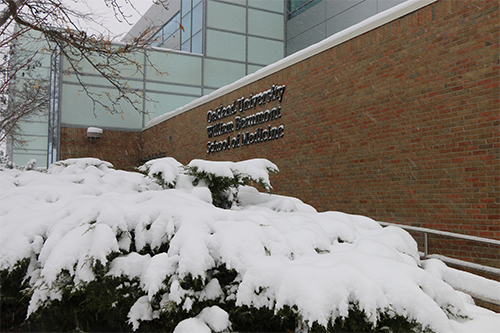
The old saying “Michigan has two seasons, construction and winter” might elicit a chuckle, but like most clichés, there’s a bit of truth to it.
Fortunately (or unfortunately if you’re a fan of snow and ice), the current late fall/early winter season in southeast Michigan has been relatively tame.
However, there’s still a lot of winter left — meaning plenty of chances of seeing bad conditions for driving.
That’s why it’s important to be prepared to drive in severe weather conditions, especially if trying to get around in a wintry mix is new, said Rachel Wilson, lead instructor, AAA – The Auto Club Group of Michigan. -page-001.jpg) Such preparations range from learning new driving techniques to getting your vehicle ready for a big snow event (see list at right).
Such preparations range from learning new driving techniques to getting your vehicle ready for a big snow event (see list at right).
Wilson, an alumna of Oakland University, recently visited campus to present a seminar on winter driving to students from Oakland University William Beaumont School of Medicine. The school has many students from states like California, Arizona, and Florida — locations that have never seen snow.
“Winter driving is hard for people that are even from Michigan,” Wilson said. “For people who are new to the area, just to get a little bit of exposure (to winter driving) before they actually have to do it is important.”
Wilson talked on topics ranging from skidding and the importance of keeping windshield wipers ice-free to the need to monitor tire pressure and always have an emergency kit that includes items like cat litter. She also answered questions from students, such as if special tires are needed, what is black ice, and how to handle drivers who are more aggressive in bad conditions. (See end of story for more tips.)
The seminar is actually based on AAA’s curriculum that is presented to teens who are learning to drive, according to Wilson.
Because many OUWB students are new to driving in snow, the seminar fits in well, she said.
Nayiri Khatchadourian, a first-year medical student from California, said she wanted to learn more after driving in her first snowstorm on Nov. 11-12, during which about 10 inches of snow fell.
“It was scary,” said Khatchadourian, who added that she attended the seminar because she “would love to know how to drive safely in the snow.”
Andrew Shanholtzer, another first-year medical student at OUWB, said he’s from California and went to school for his undergrad degree in Arizona. He also attended the winter driving session.
“Driving in snow is a new experience for me,” he said. “I was driving (during the first snowstorm) and skidded a little bit. I know other people from out of state who skidded even more.
“I just want to learn to avoid any potential accidents,” Shanholtzer added.
AAA’s tips for winter driving are as follows:
Cold Weather Driving Tips
- Keep an emergency kit in your car, truck, or SUV (see graphic).
- Make sure your vehicle is mechanically prepared (see graphic).
- Never warm up a vehicle in an enclosed area, such as a garage.
Tips for Driving in the Snow
- Stay home. Only go out if necessary. Even if you can drive well in bad weather, it’s better to avoid taking unnecessary risks by venturing out.
- Drive slowly. Always adjust your speed down to account for lower traction when driving on snow or ice.
- Accelerate and decelerate slowly. Apply the gas slowly to regain traction and avoid skids. Don’t try to get moving in a hurry and take time to slow down for a stoplight. Remember: It takes longer to slow down on icy roads.
- Increase your following distance to five to six seconds. This increased margin of safety will provide the longer distance needed if you have to stop.
- Know your brakes. Whether you have antilock brakes or not, keep the heel of your foot on the floor and use the ball of your foot to apply firm, steady pressure on the brake pedal.
- Don’t stop if you can avoid it. There’s a big difference in the amount of inertia it takes to start moving from a full stop versus how much it takes to get moving while still rolling. If you can slow down enough to keep rolling until a traffic light changes, do it.
- Don’t power up hills. Applying extra gas on snow-covered roads will just make your wheels spin. Try to get a little inertia going before you reach the hill and let that inertia carry you to the top. As you reach the crest of the hill, reduce your speed and proceed downhill slowly.
- Don’t stop going up a hill. There’s nothing worse than trying to get moving up a hill on an icy road. Get some inertia going on a flat roadway before you take on the hill.
- Do not use cruise control when driving on any slippery surface, such as on ice and snow.
For more information, contact Andrew Dietderich, marketing writer, OUWB, at [email protected].

